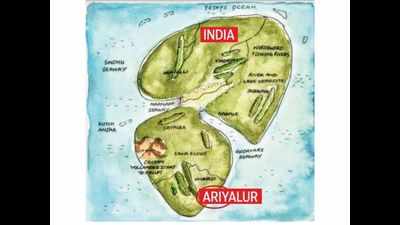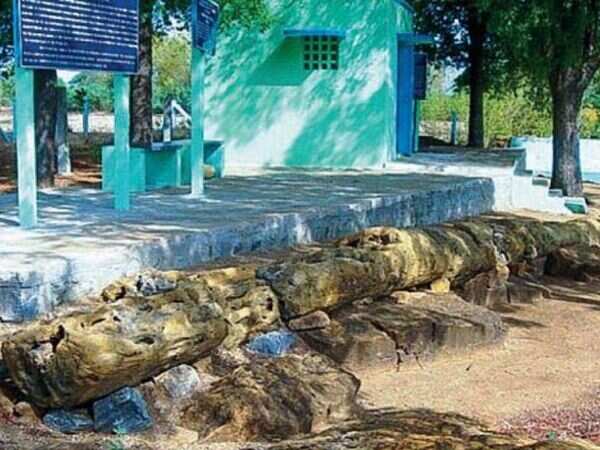- News
- City News
- chennai News
- When landlocked Ariyalur was a sea bed
Trending
This story is from September 2, 2020
When landlocked Ariyalur was a sea bed
Who would have imagined Ariyalur which is more than 100km inlands now was once a seabed? In the Cretaceous period, the third and final period of the Mesozoic Era that lasted from about 145 to 66 million years ago, Ariyalur and the areas surrounding it were submerged.

Who would have imagined Ariyalur which is more than 100km inlands now was once a seabed? In the Cretaceous period, the third and final period of the Mesozoic Era that lasted from about 145 to 66 million years ago, Ariyalur and the areas surrounding it were submerged.
“The Indo-Pacific sea had transgressed between today’s Puducherry and Karaikal and after some 80 million years had regressed leaving millions of creatures dead in the dry sea bed,” according to S M Chandrasekar, a geologist involved in fossil excavation and research in Ariyalur.

World eons ago: Fossilised remains of trees at the Fossil Wood Park in Sathanur, near Ariyalur; (below) representative map of the Cretaceous period shows Ariyalur was a coastal town
Tracing the formative years of the Earth, he said the Indian mass was still a flotilla moving fast towards her big bang into the current Central Asian mass.
About 70km radius around Ariyalur, which constitute present-day Ariyalur, Trichy, Perambalur and Cuddalore districts, is a region of well-preserved fossils and corals.
“It must have been a shallow sea for corals to grow. The area has land formations of ravines, gullies, jagged towers of sand and rock. It is a marine graveyard with abundant fossilised sea creatures and corals,” he said. The whole area has sedimentary limestone of marine origin.
“That’s why the area abounds in cement plants for which lime is the main component,” he said. “Though the cement factories are the best sites to chance upon fossils without extra expenditure, they end up destroying fossils along with the lime soil, a boon and bane at the same time,” he said.
The Mesozoic Era (also called age of reptiles) is calculated between 252 to 66 million years ago. “The era is split into Triassic, Jurassic and Cretaceous. The Carboniferous period refers to coal-bearing, suggesting many coal beds that provide for the coal we use today were created during this time,” he said.
A marine transgression is a geologic event when the sea level rises relative to the land and the shoreline moves toward higher ground, resulting in flooding. The Cretaceous period (146.5-65.5=81 million years) witnessed five phases of marine transgression that can be seen in villages around Ariyalur, said Chandrasekar, an expert in fossil and sedimentary petrology. There are two wood fossil parks in Tamil Nadu. While the National Fossil Wood Park in Tiruvakkarai has petrified wood fossils more than 20 million years old, the Sathanur fossil wood park possesses wood fossils belonging to 120 million years ago.
“There is an 18-metre-long conifer lying guarded by railings. It is thought to be over 120 million years old with a lot of marine and land animal fossils embedded in it. The petrified dinosaur egg and an ammonite coil in the guard’s room stand testimony to the marine transgression,” he said.
“The Indo-Pacific sea had transgressed between today’s Puducherry and Karaikal and after some 80 million years had regressed leaving millions of creatures dead in the dry sea bed,” according to S M Chandrasekar, a geologist involved in fossil excavation and research in Ariyalur.

World eons ago: Fossilised remains of trees at the Fossil Wood Park in Sathanur, near Ariyalur; (below) representative map of the Cretaceous period shows Ariyalur was a coastal town
At the webinar ‘Ariyalur: The Fossil Field’ organised by Heritage Inspired to create awareness among people about the importance of Ariyalur on the geographic map of the world, Chandrasekar explained how millions of years ago underwater creatures turned into fossils.
Tracing the formative years of the Earth, he said the Indian mass was still a flotilla moving fast towards her big bang into the current Central Asian mass.
About 70km radius around Ariyalur, which constitute present-day Ariyalur, Trichy, Perambalur and Cuddalore districts, is a region of well-preserved fossils and corals.
“It must have been a shallow sea for corals to grow. The area has land formations of ravines, gullies, jagged towers of sand and rock. It is a marine graveyard with abundant fossilised sea creatures and corals,” he said. The whole area has sedimentary limestone of marine origin.
“That’s why the area abounds in cement plants for which lime is the main component,” he said. “Though the cement factories are the best sites to chance upon fossils without extra expenditure, they end up destroying fossils along with the lime soil, a boon and bane at the same time,” he said.
The Mesozoic Era (also called age of reptiles) is calculated between 252 to 66 million years ago. “The era is split into Triassic, Jurassic and Cretaceous. The Carboniferous period refers to coal-bearing, suggesting many coal beds that provide for the coal we use today were created during this time,” he said.
A marine transgression is a geologic event when the sea level rises relative to the land and the shoreline moves toward higher ground, resulting in flooding. The Cretaceous period (146.5-65.5=81 million years) witnessed five phases of marine transgression that can be seen in villages around Ariyalur, said Chandrasekar, an expert in fossil and sedimentary petrology. There are two wood fossil parks in Tamil Nadu. While the National Fossil Wood Park in Tiruvakkarai has petrified wood fossils more than 20 million years old, the Sathanur fossil wood park possesses wood fossils belonging to 120 million years ago.
“There is an 18-metre-long conifer lying guarded by railings. It is thought to be over 120 million years old with a lot of marine and land animal fossils embedded in it. The petrified dinosaur egg and an ammonite coil in the guard’s room stand testimony to the marine transgression,” he said.
End of Article
FOLLOW US ON SOCIAL MEDIA










